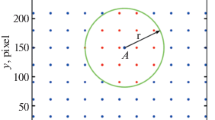Abstract
The estimation of shear strength of rock mass discontinuity is always a focal, but difficult, problem in the field of geotechnical engineering. Considering the disadvantages and limitation of existing estimation methods, a new approach based on the shadow area percentage (SAP) that can be used to quantify surface roughness is proposed in this article. Firstly, by the help of laser scanning technique, the three-dimensional model of the surface of rock discontinuity was established. Secondly, a light source was simulated, and there would be some shadows produced on the model surface. Thirdly, to obtain the value of SAP of each specimen, the shadow detection technique was introduced for use. Fourthly, compared with the result from direct shear testing and based on statistics, an empirical formula was found among SAP, normal stress, and shear strength. Data of Yujian (鱼简) River were used as an example, and the following conclusions have been made. (1) In the case of equal normal stress, the peak shear stress is positively proportional to the SAP. (2) The formula for estimating was derived, and the predictions of peak-shear strength made with this equation well agreed with the experimental results obtained in laboratory tests.
Similar content being viewed by others
References Cited
Barton, N., Choubey, V., 1977. The Shear Strength of Rock Joints in Theory and Practice. Rock Mech., 10: 1–54, doi:10.1007/BF01261801
Du, S. G., 1999. The Engineering Properties of Rock Joints. Earthquake Press, Beijing. 48–53 (in Chinese)
Du, S. G., Hu, Y. J., Hu, X. F., et al., 2011. Comparison between Empirical Estimation by JRC-JCS Model and Direct Shear Test for Joint Shear Strength. Journal of Earth Science, 22(3): 411–420, doi:10.1007/s12583-011-0193-6
Du, S. G., Hu, Y. J., Hu, X. F., 2009. Measurement of Joint Roughness Coefficient by Using Profilograph and Roughness Ruler. Journal of Earth Science, 20(5): 890–896, doi:10.1007/s12583-009-0075-3
Ge, Y. F., Tang, H. M., Liu, X., et al., 2011. Error Analysis in Direct Shear Rock-Mass Structural Tests. Journal of China University of Mining & Technology, 40(4): 549–555 (in Chinese with English Abstract)
Grasselli, G., Egger, P., 2000. 3D Surface Characterization for the Prediction of the Shear Strength of Rough Joint. In: Proc. Eurock 2000, Aachen, Germany. 281–286
Guo, X., 2001. Study on Shear Strength-Method of Rock Joints Based on Experimental Comparison: [Dissertation]. Zhejiang University of Technology, Hangzhou. 3–5 (in Chinese)
Kulatilake, P. H. S. W., Balasingam, P., Park, J. Y., et al., 2006. Natural Rock Joint Roughness Quantification through Fractal Techniques. Geotechnical and Geological Engineering, 24: 1181–1202, doi:10.1007/s10706-005-1219-6
Ladanyi, B., Archambault, G., 1970. Simulation of Shear Behaviour of a Jointed Rock Mass. In: Proc. 11th U.S. Symposium on Rock Mechanics (USRMS), Berkeley. 7: 1195–1210
Lee, S. W., Hong, E. S., Bae, S. I., et al., 2006. Modelling of Rock Joint Shear Strength Using Surface Roughness Parameter, R s. Tunnelling and Underground Sapce Technology, 21(3–4): 239–244
Xie, M. C., 2003. Research of Image Method Applied on the Shear Strength of Artificial Joint Surface: [Dissertation]. National Cheng Kung University, Tainan. 12–75 (in Chinese)
Patton, F. D., 1966. Multiple Modes of Shear Failure in Rock. In: Proc. First Congress of International Society of Rock Mechanics, Lisbon, Portugal. 509–513
Wang, W. X., Yang, J. M., 2010. A Geometric Information on Roughness of Rock Fractures Based on Image Processing. Journal of Chongqing University of Posts and Telecommunications (Natural Science Edition), 22(4): 454–457 (in Chinese with English Abstract)
Yan, Y. R., 2005. Study on Shear Strength-Method of Rock Joints Applied in Engineering: [Dissertation]. Zhejiang University of Technology, Hangzhou. 19–38 (in Chinese)
Author information
Authors and Affiliations
Corresponding author
Additional information
This study was supported by the China Geological Survey (No. 1212011014030) and the Major State Basic Research Development Program of China (973 Program) (No. 2011CB710600).
Rights and permissions
About this article
Cite this article
Tang, H., Ge, Y., Wang, L. et al. Study on estimation method of rock mass discontinuity shear strength based on three-dimensional laser scanning and image technique. J. Earth Sci. 23, 908–913 (2012). https://doi.org/10.1007/s12583-012-0301-2
Received:
Accepted:
Published:
Issue Date:
DOI: https://doi.org/10.1007/s12583-012-0301-2




